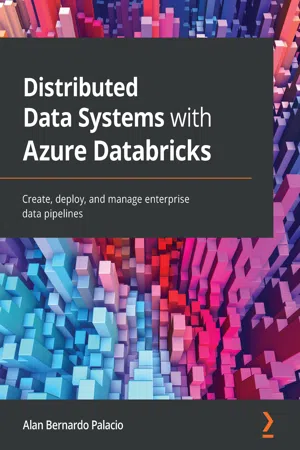
Distributed Data Systems with Azure Databricks
Create, deploy, and manage enterprise data pipelines
- 414 pages
- English
- ePUB (mobile friendly)
- Available on iOS & Android
Distributed Data Systems with Azure Databricks
Create, deploy, and manage enterprise data pipelines
About this book
Quickly build and deploy massive data pipelines and improve productivity using Azure Databricks
Key Features
- Get to grips with the distributed training and deployment of machine learning and deep learning models
- Learn how ETLs are integrated with Azure Data Factory and Delta Lake
- Explore deep learning and machine learning models in a distributed computing infrastructure
Book Description
Microsoft Azure Databricks helps you to harness the power of distributed computing and apply it to create robust data pipelines, along with training and deploying machine learning and deep learning models. Databricks' advanced features enable developers to process, transform, and explore data. Distributed Data Systems with Azure Databricks will help you to put your knowledge of Databricks to work to create big data pipelines.
The book provides a hands-on approach to implementing Azure Databricks and its associated methodologies that will make you productive in no time. Complete with detailed explanations of essential concepts, practical examples, and self-assessment questions, you'll begin with a quick introduction to Databricks core functionalities, before performing distributed model training and inference using TensorFlow and Spark MLlib. As you advance, you'll explore MLflow Model Serving on Azure Databricks and implement distributed training pipelines using HorovodRunner in Databricks.
Finally, you'll discover how to transform, use, and obtain insights from massive amounts of data to train predictive models and create entire fully working data pipelines. By the end of this MS Azure book, you'll have gained a solid understanding of how to work with Databricks to create and manage an entire big data pipeline.
What you will learn
- Create ETLs for big data in Azure Databricks
- Train, manage, and deploy machine learning and deep learning models
- Integrate Databricks with Azure Data Factory for extract, transform, load (ETL) pipeline creation
- Discover how to use Horovod for distributed deep learning
- Find out how to use Delta Engine to query and process data from Delta Lake
- Understand how to use Data Factory in combination with Databricks
- Use Structured Streaming in a production-like environment
Who this book is for
This book is for software engineers, machine learning engineers, data scientists, and data engineers who are new to Azure Databricks and want to build high-quality data pipelines without worrying about infrastructure. Knowledge of Azure Databricks basics is required to learn the concepts covered in this book more effectively. A basic understanding of machine learning concepts and beginner-level Python programming knowledge is also recommended.
Frequently asked questions
- Essential is ideal for learners and professionals who enjoy exploring a wide range of subjects. Access the Essential Library with 800,000+ trusted titles and best-sellers across business, personal growth, and the humanities. Includes unlimited reading time and Standard Read Aloud voice.
- Complete: Perfect for advanced learners and researchers needing full, unrestricted access. Unlock 1.4M+ books across hundreds of subjects, including academic and specialized titles. The Complete Plan also includes advanced features like Premium Read Aloud and Research Assistant.
Please note we cannot support devices running on iOS 13 and Android 7 or earlier. Learn more about using the app.
Information
Section 1: Introducing Databricks
- Chapter 1, Introduction to Azure Databricks
- Chapter 2, Creating an Azure Databricks Workspace
Chapter 1: Introduction to Azure Databricks
- Introducing Apache Spark
- Introducing Azure Databricks
- Discovering core concepts and terminology
- Interacting with the Azure Databricks workspace
- Using Azure Databricks notebooks
- Exploring data management
- Exploring computation management
- Exploring authentication and authorization
Technical requirements
Introducing Apache Spark
- Easy cluster management
- Data integration and ETL procedures
- Interactive advanced analytics
- ML and deep learning
- Real-time data processing
- Users need to provide a database infrastructure to store the information to work with.
- The in-memory processing feature makes it fast to run, but also implies that it has high memory requirements.
- It isn't well suited for real-time analytics.
- It has an inherent complexity with a significant learning curve.
- Because of its open source nature, it lacks dedicated training and customer support.
Introducing Azure Databricks
- Highly reliable data pipelines
- Data science at scale ...
Table of contents
- Distributed Data Systems with Azure Databricks
- Contributors
- Preface
- Section 1: Introducing Databricks
- Chapter 1: Introduction to Azure Databricks
- Chapter 2: Creating an Azure Databricks Workspace
- Section 2: Data Pipelines with Databricks
- Chapter 3: Creating ETL Operations with Azure Databricks
- Chapter 4: Delta Lake with Azure Databricks
- Chapter 5: Introducing Delta Engine
- Chapter 6: Introducing Structured Streaming
- Section 3: Machine and Deep Learning with Databricks
- Chapter 7: Using Python Libraries in Azure Databricks
- Chapter 8: Databricks Runtime for Machine Learning
- Chapter 9: Databricks Runtime for Deep Learning
- Chapter 10: Model Tracking and Tuning in Azure Databricks
- Chapter 11: Managing and Serving Models with MLflow and MLeap
- Chapter 12: Distributed Deep Learning in Azure Databricks
- Other Books You May Enjoy